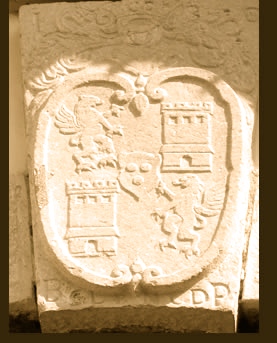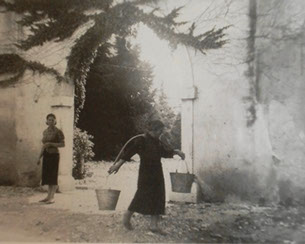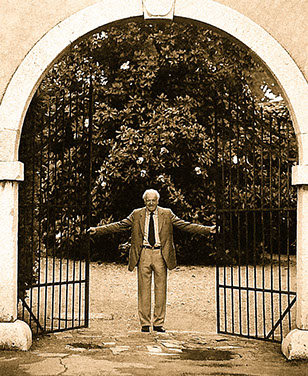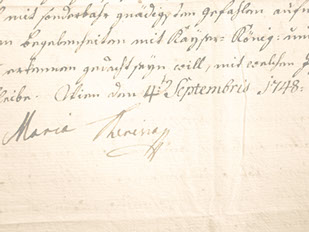
The Attems family origins
Friuli is the crib of the Attems family, as a 1025 document reports, preserved in the family historical archive.
Corrado Attems gives the “Attems infra Comitatus Fori Julii” land to the family of his wife Matilde, marchioness of Moosburg. Wolfgang d’Attimis is the forefather of the Petzestein family branch.
In 1540, he becomes the county vice-captain and commissions the construction of the Montesanto sanctuary.
Archduke Carlo of Austria grants Wolfgang’s son, Andrea, the right to add the title von Petzenstein to his name. In the XVIII century, under Maria Theresa of Austria’s sovereignty, Sigismondo, Carlo Michele, and Lodovico were among Andrea’s von Petzenstein descendants who best prove themselves.
All three bring prestige to Gorizia, but most of all Carlo Michele, who Maria Theresa nominates him Prince of the Holy Roman Empire until 12 April 1752, when Pope Benedetto XIV appoints him Archbishop of Gorizia.
The Attems estate
XIII-century documents state that the Attems estate, located in
Lucinico in the heart of Collio, belongs to the old Goriziana
noble family of Postcastros.
However, the Cernozzas, another old Goriziana noble family, inherit the entire assets.
In fact further documentation proves that, in 1546, archduke Ferdinando allows them to succeed in the feudal part.
The succession is validated with the evolution of the family name in Cernozza de Postcastro.
Therefore, the Cernozzas become the last land owners before the arrival of the Attems family in Lucinico.
During this time, the keystone standing above the entrance portal to the park of Villa Attems acquires a central position.
Above the shield helmet, the crest displays the year 1630 and the acronym BGLBNCDP meaning Beninia Gallara free baroness born Cernozza de Postcastro underneath it.


In 1649, Beninia’s niece marries Massimiliano Attems bringing
the estate as dowry.
From that moment on, the property in Lucinico becomes part of the Attems’ asset.
Hence, since then, the Attems are known as “descendants of the Cernozza de Postcastro”.
In the XX century, Count Sigismondo Douglas Attems Petzenstein continues the noble descent of the old and aristocratic lineage.
He is born on 23 May 1914 from Count Giovanni and Baroness Stefania Biedermann de Turony, exactly one prior Italy’s declaration of war against the Austria-Hungary Empire, which, ultimately, sets off the beginning of a geopolitical and territorial transformation.
Count Douglas Attems
Lucinico becomes war zone, a land devastated by continuous raids and pillage.
It is completely destroyed as the Italian and Austrian fronts alternated in power.
After four long years, the corner of paradise, the Austrian Nice, which historian Carl von Czoernig-Czernhausen celebrates in his works, is only a shadow in survivors’ memories.
Years go by, but Douglas proves to be as determined, lucid, and resolute as a XVIII-century gentleman. His perspicacity guides him, as he turns Collio into a unique product, representative of the entire Goriziano territory.
In 1963, he promotes the realization of the Collio Consortium and two years later, he becomes its President in name of the high hope to protect the territory and its borders.
Virginia and Paolo continues the dinasty
To Douglas, Collio is everything. He creates the “Denominazione d’Origine Controllata” (D.O.C.) Collio, which he runs as President until 1999.
He dies in 2002, a year after her only daughter Virginia marries Paolo Giasone in September 2001.
From their love, Eugenia and Ludovica are born. The Ministry of Domestic Affairs granted their daughters the right to add Attems Petzenstein to their paternal last name. In this way, Douglas’ wish to continue the Attems millenial ancestry after his death is fulfilled.
In 2009, Paolo and Virginia iasone Attems Petzenstein write a book which reconstruct their family history in the XX century.
The book, Sigismondo Douglas Attems Petzenstein Conte del S.R.I. Storia di una famiglia nella Mitteleuropa del ‘900, is published by Edizioni della Laguna.


The estate business
Since 1945, the estate, now dedicated to this new enterprise,
manages wine trading, poultry farming, and rabbit breeding.
During the same period of time, not far from this facility, the building designated to the wine cellar is expanded in order to invest more in wine production and marketing.
